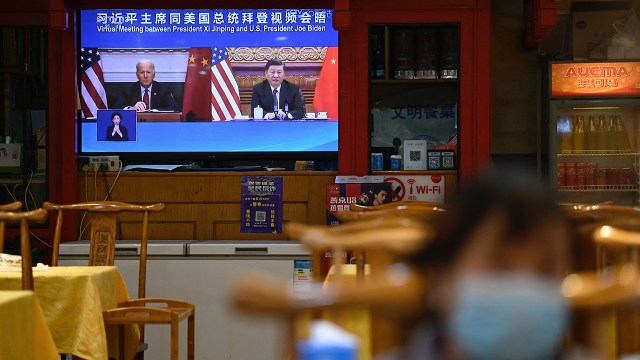
In 19 countries surveyed by Pew Research Center this spring, people see the United States and President Joe Biden more favorably than China and its president, Xi Jinping. But when it comes to perceptions of each country’s relative influence in the world, much larger shares in most nations see China’s influence growing than say the same of the U.S.
Below are five key findings comparing international attitudes toward the two countries, drawn from nationally representative surveys conducted from Feb. 14 to June 3, 2022, among 24,525 adults in 19 nations.
This Pew Research Center analysis focuses on public opinion of the United States and China in 19 countries in North America, Europe, the Middle East and the Asia-Pacific region. For non-U.S. data, we draw on nationally representative surveys of 20,944 adults from Feb. 14 to June 3, 2022. All surveys were conducted over the phone with adults in Canada, Belgium, France, Germany, Greece, Italy, the Netherlands, Spain, Sweden, the United Kingdom, Japan, Malaysia, Singapore and South Korea. Surveys were conducted face to face in Hungary, Poland and Israel and online in Australia.
In the U.S., we surveyed 3,581 U.S. adults from March 21 to 27, 2022. Everyone who took part in the U.S. survey is a member of the Center’s American Trends Panel (ATP), an online survey panel that is recruited through national, random sampling of residential addresses. This way nearly all adults have a chance of selection. The survey is weighted to be representative of the U.S. adult population by gender, race, ethnicity, partisan affiliation, education and other categories. Read more about the ATP’s methodology.
Here are the questions used in this report, along with their responses, as well as its methodology.
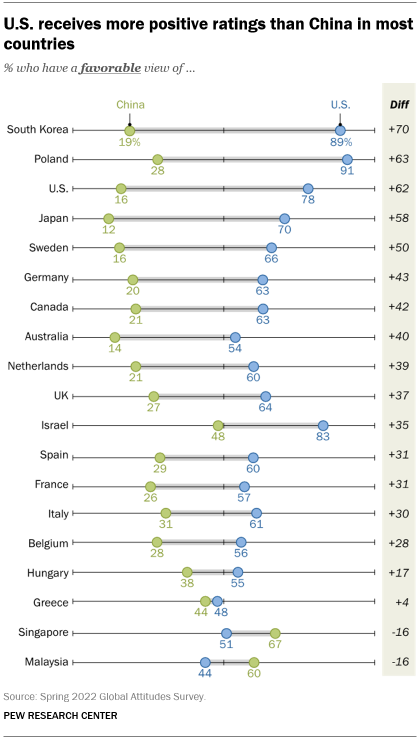
The U.S. is generally seen more positively than China. In most countries, majorities have a favorable view of the U.S., while fewer than around a third tend to say the same of China. However, attitudes vary widely within the Asia-Pacific region. In South Korea, 89% have a favorable view of the U.S., 70 percentage points more than the 19% who say the same of China. This is the widest gap observed among all 19 countries. The U.S. is also seen substantially more positively than China in Japan (+58 points) and Australia (+40 points). Conversely, more people in Malaysia and Singapore hold favorable views of China than the U.S. In both countries, the share who see China positively is 16 points greater than the share who see the U.S. in the same light.
While views of the U.S. and China have remained mostly stable over the past year, attitudes in some countries have shifted. People in Greece and Italy, for example, see both the U.S. and China less favorably today than in 2021. In Hungary, which was last surveyed in 2019, views of the U.S. are down while opinion of China has not shifted. The pattern differs in Poland, also last surveyed in 2019, where the U.S. is now seen more favorably than three years ago (+12 points) while China is seen less favorably (-19 points).
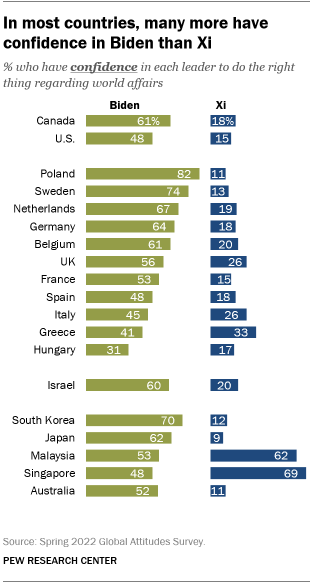
Views of Biden remain much more positive than views of Xi. Outside of Singapore and Malaysia, people in every nation surveyed have more confidence in Biden than in Xi – and in Poland and Sweden, the difference is greater than 60 percentage points. But while many more continue to have confidence in Biden, positive views of his leadership have taken a downward turn in the past year, falling by double digits in nearly every country surveyed. Views of Xi, by comparison, have remained largely unchanged over the past year, though they continue to hover at or near historic lows in most places.
A median of 66% across 19 countries say China’s influence on the world stage is getting stronger, while just 32% say the same about the U.S. This gap in perceptions is largest in Australia, where more than three times as many say China’s influence is growing than say the same about American influence (73% vs. 19%).
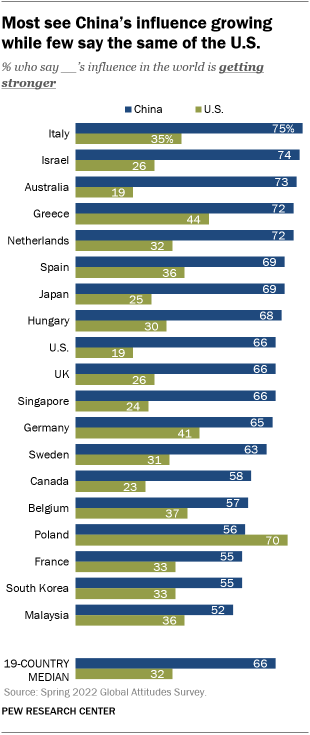
In each country surveyed, more than half of adults say China’s influence in the world is strengthening. Few tend to describe China’s influence as staying the same (median of 20%) or getting weaker (12%).
Evaluations of America’s global influence vary more widely. Across the surveyed countries, a median of 32% describe U.S. influence as getting stronger, while 37% say it is staying the same and 27% say it is getting weaker. In contrast to views of China’s influence, more than half of the public in only one country – Poland – say U.S. influence is growing. At the same time, however, there are no countries where more than half say U.S. influence is weakening, either.
Across most countries surveyed, more educated people are more likely to say China’s power is growing. In about a third of the places surveyed, more educated people are also more likely to say that U.S. influence is getting weaker.
In many countries, younger people tend to feel more positively about China than older people. In 12 of the 18 countries surveyed, including the U.S., those under age 30 have more favorable views of China than those ages 50 and older, with the largest difference in Japan.
When it comes to views of the U.S., the pattern is more varied. In Australia, the Netherlands and Sweden, for example, younger people have much less positive views of the U.S. than older people do. In Malaysia, Singapore and Spain, the opposite is true.
Taken together, young people in a few countries – including Australia, Belgium, Canada, Sweden and the United Kingdom – are both more positive toward China and less positive toward the U.S. than older adults. South Korea is the only place surveyed where younger people have more negative views of China and more positive views of the U.S. than their older counterparts.
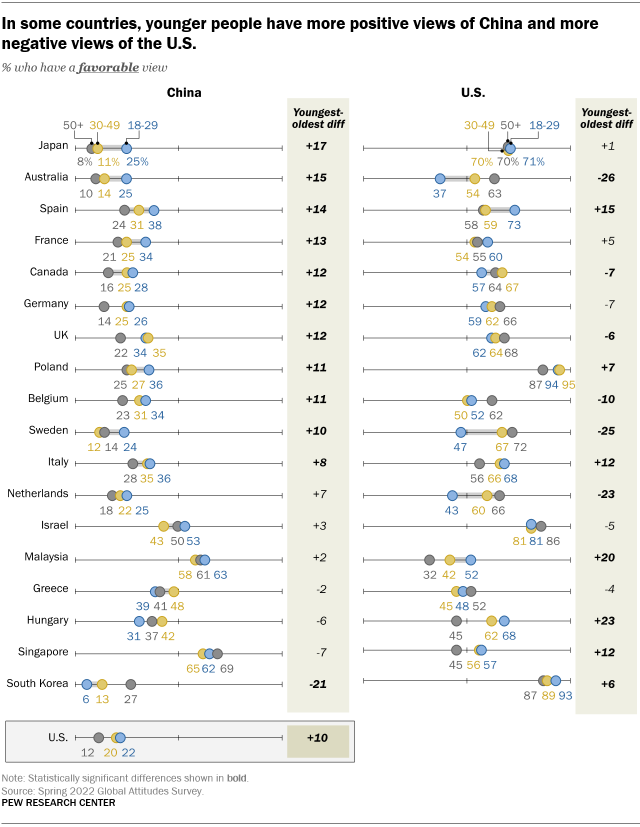
People on the right of the ideological spectrum are more likely than those on the left to view the U.S. favorably, but there are no strong ideological patterns in views of China. As we have seen consistently in Pew Research Center surveys, people who place themselves on the right of the ideological spectrum tend to view the U.S. more favorably than those on the left. For instance, in Greece, 60% of those on the right have a favorable view of the U.S., compared with only 22% of those on the left. This pattern can also be seen in Australia, Belgium, Canada, France, Israel, the Netherlands, Spain, South Korea, Sweden and the UK. (Ideology was not asked in Japan, Malaysia or Singapore.)
In most countries, people on the ideological right and left feel similarly about China. The notable exceptions are Hungary and Italy, where those on the right are more likely than those on the left to see China favorably.
CORRECTION (Aug. 29, 2022): Due to an editing error, a previous version of the text mischaracterized favorable views of the U.S. in South Korea. This change does not substantively affect the findings in this analysis.
Note: Here are the questions used in this report, along with their responses, as well as its methodology and full dataset.